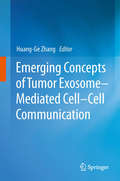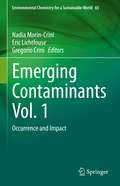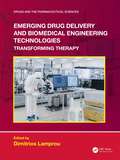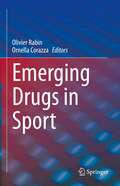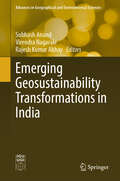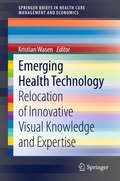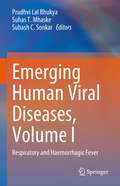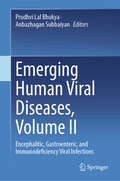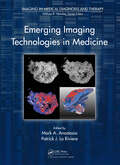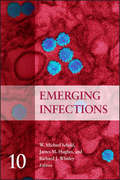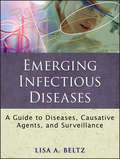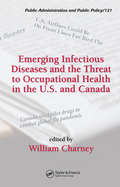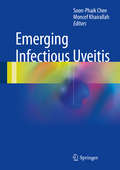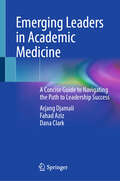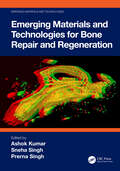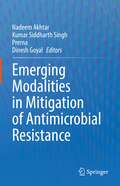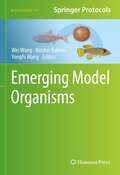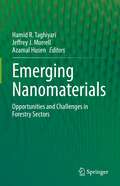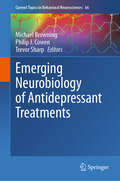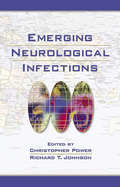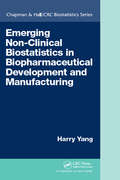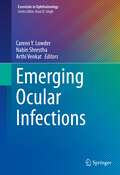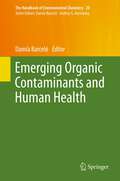- Table View
- List View
Emerging Concepts of Tumor Exosome–Mediated Cell-Cell Communication
by Huang-Ge ZhangIn multicellular organisms, communication between cells involves secretion of proteins that bind to receptors on neighboring cells. While this has been well documented, another mode of intercellular communication has recently become the subject of increasing interest: the release of exosomes. In cancer, tumor exosomes are involved in various aspects of pathogenesis, including proliferation, immunosuppression, and metastasis. Given the ability of exosomes to export unneeded endogenous molecules from cells, these structures hold great potential as anticancer therapeutic agents. They are also being studied as prognostic markers for cancer.
Emerging Contaminants Vol. 1: Occurrence and Impact (Environmental Chemistry for a Sustainable World #65)
by Eric Lichtfouse Grégorio Crini Nadia Morin-CriniEmerging contaminants are chemical and biological agents for which there is growing concern about their potential health and environmental effects. The threat lies in the fact that the sources, fate and toxicology of most of these compounds have not yet been studied. Emerging contaminants, therefore, include a large number of both recently discovered and well-known compounds such as rare earth elements, viruses, bacteria, nanomaterials, microplastics, pharmaceuticals, endocrine disruptors, hormones, personal care products, cosmetics, pesticides, surfactants and industrial chemicals. Emerging contaminants have been found in many daily products, and some of them accumulate in the food chain. Correlations have been observed between aquatic pollution by emerging contaminants and discharges from wastewater treatment plants. Most actual remediation methods are not effective at removing emerging contaminants. This first volume presents comprehensive knowledge on emerging contaminants with a focus on analysis, toxicity, antibiotic resistance and human health.
Emerging Drug Delivery and Biomedical Engineering Technologies: Transforming Therapy (Drugs and the Pharmaceutical Sciences)
by Dimitrios LamprouThis book details the advances in drug discovery and delivery and the present need for emerging technologies. Throughout the text new micro and nanofabrication techniques are described, including methods such as electrohydrodynamic processes, additive manufacturing, and microfluidics, which have the potential to produce drug delivery systems that were not possible a few years ago. This book is of great use to both entry-level and experienced researchers in the field of emerging technologies for the manufacturing of drug delivery devices. Features: Describes technologies that are significantly enhancing the delivery of drugs and biologics Presents new data on mobile and wearable point-of-care testing systems Features hot topics such as electrospinning, 3D printing and micro-needles Focuses on additive manufacturing (AM) which can be used to provide customized treatment for patients Will appeal to experienced researchers and those considering entering the field of emerging technologies for the manufacturing of drug delivery devises
Emerging Drugs in Sport
by Ornella Corazza Olivier RabinAthletes are always aiming to be faster, better, stronger. New techniques to enhance their sporting performance have increasingly been linked to use of novel psychoactive substances (NPS) and other hard-to-detect substances like performance-enhancing drugs. This book offers a timely analysis of the new challenges posed by this phenomenon in the anti-doping community. The authors present the first comprehensive perspective on the rapidly shifting doping scenario and reflect on use, regulation, policy, and market structure of NPS used in sports. They highlight the challenges with the list of prohibited substances and methods in and out of competition. They also evaluate how methods to detect new drugs present an ongoing battle for doping control as they have to be adapted constantly. Topics covered within the chapters include:Contamination of Sports Supplements with Novel Psychoactive SubstancesUntested Supplement Use Among Athletes: An Overlooked Phenomenon?International Drug Control: Protecting the Health of the AthleteAnalysis of New Chemical Entities in a Sport Context Emerging Drugs in Sport establishes a clear benchmark on the policy discussion, drawing from available evidence and sources, including athletes' personal experiences, to generate a fact-based resource that informs a research as well as wider audience. The book is essential reading for those working in anti-doping, substance misuse, sports, ethics, and human enhancement. It also is useful for policy-makers, legislative personnel, and other professionals with an interest in protecting clean sport.“Doping is one of the greatest threats to the integrity of sport. We must never be tempted to turn our back on the problem and hope it will disappear. The benefits and values of clean sport have never been more important to the world. That is why this book with its wide-ranging approach is so valuable.” Thomas Bach, President, International Olympic Committee“Physical activity is vital to a healthy living, which is why doping is not just an assault on fair competition, but also on health. I strongly commend this book for compiling advanced knowledge on performance-enhancing drugs and promoting health through sport.” Tedros Adhanom Ghebreyesus, Director-General, World Health Organization
Emerging Electromagnetic Technologies for Brain Diseases Diagnostics, Monitoring and Therapy
by Lorenzo Crocco Irene Karanasiou Michael L James Raquel Cruz ConceiçãoThis timely book presents innovative technologies for use in the diagnosis, monitoring, and treatment of brain disease. These technologies offer exciting possibilities in the medical field owing to their low-cost, portability and safety. The authors address cerebrovascular diseases such as stroke, ischemia, haemorrhage, and vasospasm, these diseases having an ever-increasing societal relevance due to the global ageing population. The authors describe the potential of novel techniques such as microwave imaging and present innovative modalities for treatment of brain tumours using electromagnetic fields and nano-composites, as well as for monitoring brain temperature during surgery. Finally, Emerging Electromagnetic Technologies for Brain Diseases Diagnostics, Monitoring and Therapy addresses the perspectives which arise from multi-modal multi-spectral EM modalities, which make a synergic use of the different portions of the electromagnetic spectrum. This text will be of interest to readers from various different areas, given the fundamental interdisciplinarity of the subject matter. This includes researchers or practitioners in the field of electrical engineering, applied physicists, and applied mathematicians working on imaging applications for biomedical and electromagnetic technologies. Neurologists and radiologists may also find this book of interest, as may graduate students in these areas.
Emerging Geosustainability Transformations in India (Advances in Geographical and Environmental Sciences)
by Subhash Anand Virendra Nagarale Rajesh Kumar AbhayThis book presents the emerging sustainability concerns for India to achieve holistic development. India is densely populated with scattered natural resources and is engaged in developing technology and its infrastructure. However, India’s sustainability is questioned from the viewpoints of environment, society, economy and politics. As the Sustainable Development Goals (SDGs) aims to achieve a sustainable world by 2030, India has to relook at its current development approaches and make effective policy measures. Geography is an interdisciplinary branch of social science that focuses on the interrelationships among population, natural resources, social linkages, governments and public policy. Within this interdisciplinary concept, the book presents a collection of studies from scholars in India. We ask questions such as, (1) what major geographical approaches and perspectives exist related to sustainability, (2) how socioeconomic and political factors affects sustainability and SDGs, (3) what approach is the most effective from the sustainability perspective, and (4) how we address sustainability issues. The book serves as a valuable reference for those who are concerned with the progress of sustainability in India.
Emerging Health Technology
by Kristian WasenThis book reports cutting-edge cases of emerging health technologies. Some health care fields are experiencing paradigmatic shifts because of robotic technologies and the new relationships that they create in r-Health (r-Curing and r-Caring) activities. The book explores emerging health care technologies such as image-guided surgical robotics, pharmacy robots, new visualisation methods (3D, 4D & "5D") and home telehealth management systems and their acceptance in the workplace but also, more generally, their special role in business and society. These technologies allow health care professionals to effectively reach far beyond the current service offerings, providing new methods for communication, diagnosis, and treatment. The relocation of certain knowledge areas from physicians to patients in self-care management or the reconfiguration of health care expertise from one health profession to another are examples of topics developed in this book. The book describes the emerging relocation of innovative visual knowledge and expertise within health care organisations and beyond, such as in the patient's home environment.
Emerging Human Viral Diseases, Volume I: Respiratory and Haemorrhagic Fever
by Prudhvi Lal Bhukya Suhas T. Mhaske Subash C. SonkarThe first volume of the book-Emerging Human Viral diseases presents pathogenesis, diagnostics, and therapeutic strategies against viral respiratory and hemorrhagic fever diseases. The initial chapter discusses the underlying factors contributing to the emergence of these viral diseases. The subsequent chapters introduce structure, composition, and organization of viral genomes, and provide insight into function of important viral proteins. It also discusses the host factors that influence the outcome of viral infection and host immune response to the infections caused by these viruses. The book also discusses clinical manifestation and strategies for the prevention of virus diseases and highlights the recent technical advances in the diagnosis of virus diseases, prevention, and control strategies for viral infections. This timely book offers valuable resource for the scientists working in the field of emerging viral infections and those involved in preventing, controlling, and managing viral diseases.
Emerging Human Viral Diseases, Volume II: Encephalitic, Gastroenteric, and Immunodeficiency Viral Infections
by Prudhvi Lal Bhukya Anbazhagan SubbaiyanThe second volume of the book Emerging Human Viral Diseases discusses pathogenesis, diagnostics, and therapeutic strategies against viral encephalitis, gastroenteritis, and human immunodeficiency viral infections. The chapters discuss symptoms, diagnostics, and preventive strategies against viral infections. The book also reviews the epidemiology and evolution of viruses causing these infections. It also examines symptoms and strategies for developing novel diagnostics and the vaccine against these viruses. Toward the end, it discusses various biosafety principles for handling emerging viruses and reviews various bioinformatics tools and databases in virology research. This timely book offers valuable resource for the scientists working in the field of emerging viral infections and those involved in preventing, controlling, and managing viral diseases. Inclusively this book will be valuable guide covering most recent scientific progress in emerging human viral diseases and management and will serve as the best resource for undergraduates, graduates, medical professionals, researchers, public health physicians, and national and international health authorities.
Emerging Imaging Technologies in Medicine
by Mark A. Anastasio Patrick La RiviereFrom the discovery of x-rays in 1895 through the emergence of computed tomography (CT) in the 1970s and magnetic resonance imaging (MRI) in the 1980s, non-invasive imaging has revolutionized the practice of medicine. While these technologies have thoroughly penetrated clinical practice, scientists continue to develop novel approaches that promise t
Emerging Infections 10 (ASM Books #10)
by James Hughes Richard Whitley W. ScheldEssential resource for the fight against emerging infectious diseases Incidences such as the 2014 Ebola epidemic in West Africa and the 2015 appearance of Zika in Brazil provide dramatic evidence of the continued ability of microbes to emerge, spread, adapt, and threaten global health. The challenge facing infectious disease specialists and public health professionals is to improve and find new diagnostic, therapeutic, and prevention strategies. The editors of the 10th installment of the Emerging Infections series have compiled the perspectives of leading infectious disease experts into 22 chapters that provide important updates on a broad range of emerging and reemerging bacterial, viral, parasitic, and fungal infectious diseases in the United States and globally. In addition to focusing on MERS, Ebola virus disease, chikungunya, and Zika virus disease, Emerging Infections 10 explores the global threat of antimicrobial resistance in reviews on carbapenem-resistant Enterobacteriaceae, multiply-resistant gonococcal infections, non-typhoidal Salmonella infections, and artemisinin-resistant Plasmodium falciparum malaria. Topics include both recently- and long-recognized diseases that pose challenges for the clinical, laboratory, research, public health, and animal health communities. Emerging Infections 10 presents new and emerging strategies to prevent, control, and eradicate infectious diseases and guides readers to the primary literature where they can explore individual topics in greater depth. This book is a valuable reference for professionals in microbiology, epidemiology, public health, and clinical and veterinary medicine.
Emerging Infectious Diseases
by Lisa A. BeltzEmerging Infectious Diseases offers an introduction to emerging and reemerging infectious disease, focusing on significant illnesses found in various regions of the world. Many of these diseases strike tropical regions or developing countries with particular virulence, others are found in temperate or developed areas, and still other microbes and infections are more indiscriminate. This volume includes information on the underlying mechanisms of microbial emergence, the technology used to detect them, and the strategies available to contain them. The author describes the diseases and their causative agents that are major factors in the health of populations the world over. The book contains up-to-date selections from infectious disease journals as well as information from the Centers for Disease Control and Prevention, the World Health Organization, MedLine Plus, and the American Society for Microbiology. Perfect for students or those new to the field, the book contains Summary Overviews (thumbnail sketches of the basic information about the microbe and the associated disease under examination), Review Questions (testing students' knowledge of the material), and Topics for Further Discussion (encouraging a wider conversation on the implications of the disease and challenging students to think creatively to develop new solutions). This important volume provides broad coverage of a variety of emerging infectious diseases, of which most are directly important to health practitioners in the United States.
Emerging Infectious Diseases and the Threat to Occupational Health in the U.S. and Canada (Public Administration and Public Policy)
by William CharneyHospitals in the US and Canada are ill-prepared for the threat of emerging infectious diseases, especially in the area of protecting healthcare workers, nurses, doctors, and first responders from transmissions. Current protocols from guideline agencies and health organizations and health departments that include state pandemic flu plans do not foll
Emerging Infectious Diseases from the Global to the Local Perspective: A Summary of a Workshop of the Forum on Emerging Infections
by Institute of MedicineIn October 1999, the Forum on Emerging Infections of the Institute of Medicine convened a two-day workshop titled “International Aspects of Emerging Infections.” Key representatives from the international community explored the forces that drive emerging infectious diseases to prominence. Representatives from the Americas, Africa, Asia and the Pacific, and Europe made formal presentations and engaged in panel discussions. Emerging Infectious Diseases from the Global to the Local Perspective includes summaries of the formal presentations and suggests an agenda for future action. The topics addressed cover a wide range of issues, including trends in the incidence of infectious diseases around the world, descriptions of the wide variety of factors that contribute to the emergence and reemergence of these diseases, efforts to coordinate surveillance activities and responses within and across borders, and the resource, research, and international needs that remain to be addressed.
Emerging Infectious Uveitis
by Moncef Khairallah Soon-Phaik CheeThis book reviews the various emerging infectious diseases that show a significant association with uveitis, describing and explaining their ocular manifestations with the aid of color illustrations. In addition, it presents brief reports of further emerging infections that are associated with uveitis in rare cases. The coverage is wide ranging, encompassing diverse emerging bacterial, viral, parasitic and fungal infections. Individual chapters are also devoted to important re-emergent diseases such as syphilis and tuberculosis, with the focus on new data on epidemiology, diagnosis and management. Emerging infectious diseases are defined as "those whose incidence in humans has increased within the past two decades or threatens to increase in the near future". Emergence may be due to the spread of a new agent, to the recognition of an infection that has been present in the population but has gone undetected, or to the realization that an established disease has an infectious origin. This book will be an invaluable source of information on all aspects of uveitis in these diseases.
Emerging Leaders in Academic Medicine: A Concise Guide to Navigating the Path to Leadership Success
by Fahad Aziz Dana Clark Arjang DjamaliIn the fast-paced and dynamic environment of medicine, academic leaders are crucial to driving innovation, fostering collaboration, and advancing the field to new heights. For early-stage physicians embarking on their academic careers, the journey to becoming effective leaders can be both challenging and rewarding. This book, Emerging Leaders in Academic Medicine: A Concise Guide to Navigating the Path to Leadership, is designed as a guide for aspiring academic leaders as they navigate the complexities of leadership, unlock their potential, and achieve success in their careers. By exploring topics such as personal identity, leadership styles, conflict management, feedback, mentorship, and practical considerations for academic growth, this book prepares readers with the knowledge and tools necessary to thrive as effective leaders in the complex landscape of academic institutions. Through self-reflection, skill development, and strategic planning, emerging leaders can navigate challenges, seize opportunities, and make a lasting impact on the future of healthcare and medical education.
Emerging Materials and Technologies for Bone Repair and Regeneration (Emerging Materials and Technologies)
by Prerna Singh Ashok Kumar Sneha SinghThis book covers advancements in the field of bone repair and regeneration. It introduces bone development, repair, and regeneration and details different biomaterials and technologies involved in the fabrication and characterization of bone-related scaffolds and implants. The book explores nanotechnological intervention and folklore phytomedicines and their prospects in regenerating bone including major bone related disease conditions, infection, and their tackling via tissue engineering strategies.FEATURES: Covers polymer materials and technologies for bone repair and regeneration based on tissue engineering Defines the interdisciplinary mechanism of bone tissue repair ranging from the fields of material science, nanotechnology, and phytomedicine includes basic sciences, scaffolds, and bone infection Examines fabrication and characterization methods for the bone repair materials Reviews fundamentals of interlinked mechanisms of bone development, repair, and regeneration. This book is aimed at graduate students and researchers in biomedical and tissue engineering and biomaterial sciences.
Emerging Modalities in Mitigation of Antimicrobial Resistance
by Nadeem Akhtar Dinesh Goyal Kumar Siddharth Singh PrernaAntimicrobial resistance (AMR) is one of the deadliest threats to global public health. This book focuses on dynamics in the landscape of AMR while informing about the latest technologies and strategies to mitigate it. The menace of AMR in different niches, routes of penetration across various domains, socio-economic impact, and the need for a 'One Health' approach in mitigating AMR has been emphasized. Factors involved in AMR, underlying mechanisms, and pharmacometrics in developing antimicrobials are highlighted. Emphasis is given to emerging technologies that are sustainable, scalable, and applicable to the global community, such as big data analytics, bioactive agents, phage therapy, and nanotechnology. The book also explores current and alternative treatment strategies to combat AMR, emphasizing the use of nanoparticles to target pathogens and as a viable alternative to antibiotics.
Emerging Model Organisms (Neuromethods #194)
by Wei Wang Nicolas Rohner Yongfu WangThis volume discusses different approaches towards understanding the brain plasticity, aging, and regeneration of the nervous system in model organisms. Chapters guide the reader through an overview of model organisms, setup of an aquatic system, Tol2-mediated transgenesis, CRISPR/Cas9-mediated gene knock-out and knock-in, Cas13d-mediated gene knockdown, tissue clearing and expansion methods for brain and spinal cord imaging, Histological techniques, chromatin Immunoprecipitation Sequencing (ChIP-Seq) analysis, single-cell RNA sequencing analysis, BrdU/EdU incorporation assays, brain and spinal cord injury in African killifish, and emerging technologies and future perspectives in African killifish research. In the Neuromethods series style, chapters include the kind of detail and key advice from the specialists needed to get successful results in your laboratory. Authoritative and cutting-edge, Emerging Model Organisms aims to be a useful practical guide to researches to help further their study in this field.
Emerging Nanomaterials: Opportunities and Challenges in Forestry Sectors
by Azamal Husen Hamid R. Taghiyari Jeffrey J. MorrellBio-based materials, including those containing wood, will become increasingly important as we move to a bio-based economy. Among their many attributes, it is vitally important that these materials are renewable, sustainable with proper management and environmentally benign. Wood remains one of our most important bio-based materials. While it is an amazing material, wood still has negative attributes and drawbacks that can affect performance, including dimensional instability when wetted, vulnerability to fire and high temperatures, and susceptibility to biodeterioration. A variety of treatments have been developed to overcome these weaknesses. Among the most exciting of these treatments are nanomaterials. These materials have some exceptionally attractive properties for improving timber performance and have been the subject of intensive research over the past decade. There is a tremendous need for a single comprehensive source of information on this rapidly emerging subject with tremendous potential to enhance the performance of a variety of bio-based materials. This book contains 10 chapters, each compiled by different author(s) who are considered the top researcher(s) in their respective fields. The chapters begin with some basic background on nanomaterials and their synthesis, then explore different areas for potential applications and conclude with a review of the emerging questions about nanomaterial safety. The book is designed to provide the latest information and know-how on application and utilization of different nanomaterials to improve the properties of wood and wood-based composite panels. The contents cover some main topics in the industry including improving physical and mechanical properties, increasing resistance to biodegradation (including fungi and insects), developing wood-plastic composites (WPC), applying nanomaterials in paper and board industry, and emergence of transparent wood and radiation shielding. It also covers the use of nanomaterials to improve the performance of paints and finishes used for forest products. The book provides a single location for those interested in the field to begin.
Emerging Neurobiology of Antidepressant Treatments (Current Topics in Behavioral Neurosciences #66)
by Michael Browning Trevor Sharp Philip J. CowenThis volume is unique in bringing the exciting range of antidepressant treatment developments together with a focus on their neurobiological mechanisms and how these interact with the known pathophysiology of depression. Current evidence for treatment efficacy is reviewed together with a discussion of where in the management pathway of this common condition, these new approaches might take their place.
Emerging Neurological Infections
by Christopher Power Richard T. JohnsonOffering a clear and authoritative overview of recent developments in microbiology and neuroscience, this reference describes factors contributing to the emergence and resurgence of neurological infections-studying both new and drug-resistant pathogens, as well as long-term prevention and control strategies for these diseases.
Emerging Non-Clinical Biostatistics in Biopharmaceutical Development and Manufacturing (Chapman & Hall/CRC Biostatistics Series)
by Harry YangThe premise of Quality by Design (QbD) is that the quality of the pharmaceutical product should be based upon a thorough understanding of both the product and the manufacturing process. This state-of-the-art book provides a single source of information on emerging statistical approaches to QbD and risk-based pharmaceutical development. A comprehensive resource, it combines in-depth explanations of advanced statistical methods with real-life case studies that illustrate practical applications of these methods in QbD implementation.
Emerging Ocular Infections (Essentials in Ophthalmology)
by Careen Y. Lowder Nabin Shrestha Arthi VenkatThe book offers comprehensive coverage on novel manifestations of known infections, novel infections with documented ophthalmic involvement, and the growing issue of resistance among certain infections. Filling a much-needed gap in current literary offerings, chapters approach ophthalmic manifestations of infectious disease from a novel perspective. Each chapter is co-written by an ophthalmologist and an infectious disease specialist to provide multidisciplinary insight. This unique analysis of infectious disease enhances the ability of ophthalmologists and infectious disease specialists to identify the manifold manifestations of both common and rare infections in the eye. Chapters begin with a general introduction, and each contain an Infectious Disease section, along with an Ophthalmology section. The book covers infections such as viral retinitis, fungal infections, syphilis, tuberculosis, vector-borne illnesses, and delve into rarer conditions such as unusual post-operative infections.Concise and practical, Emerging Ocular Infection will be of use to ID specialists, and ophthalmologists alike.
Emerging Organic Contaminants and Human Health
by Damia BarceloThis volume provides an overview of the occurrence and fate of emerging contaminants, discusses advanced chemical analysis methods, toxicological and ecotoxicological effects as well as human exposure. One focus is on pharmaceuticals, in particular antibiotics, and the problems associated with their increased use in hospitals. Other covered emerging contaminants occurring e.g. in food, water, air or soil include brominated flame retardants, polar pesticides, phthalates, phosphate esters, perfluorinated compounds, personal care products, musk fragrances, disinfection byproducts, illicit drugs, and nanomaterials. The chapters written by experts are a valuable source of information for a broad audience, such as analytical chemists, environmental chemists and engineers, toxicologists, ecotoxicologists and epidemiologists working already in this field as well as newcomers.
